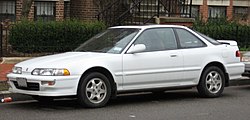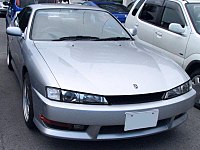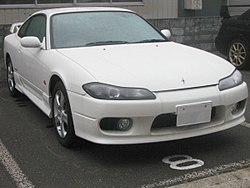Honda Integra
The Integra, a car sold as an Acura in North America, and as a Honda elsewhere was a sporty front-wheel drive vehicle sold both as a sedan and hatchback. In the Acura lineup it was the smallest, least expensive model, designed to offer a competitor to vehicles like the Volkswagen Golf GTI, which was the most well known and popular "hot hatch" of the 1980s when the Integra was introduced. Although a sedan was available for the first three generations of the Integra, it was dropped when the vehicle transitioned to its fourth generation "DC5" platform, sold as the RSX in North America. Enthusiasts refer to the Acura TSX as the second coming of the Integra GS-R sedan.
Under the Honda line up, the Integra was near the middle, slotting above smaller cars such as the Honda City, the Honda Civic, and the Honda Logo. The Honda Integra was considered to be mid-sized car by Japanese standards.
As of 2007, the fourth-generation Integra has been discontinued in North America and Australia, but is still sold in its home market of Japan.
Contents |
First generation (1986–1989)
| First generation | |
|---|---|
 | |
| Production | 1986-1989 |
| Body style(s) | 3-door hatchback 4-door sedan 5-door hatchback |
| Engine(s) | 1.6 L I4 |
| Transmission(s) | 5-speed manual 4-speed automatic |
| Wheelbase | 3-Door: 2450 mm (96.5 in) Sedan: 2520 mm (99.2 in) |
| Length | 3-Door: 4285 mm (168.7 in) 4355 mm (171.5 in) |
| Width | 1665 mm (65.6 in) |
| Height | 1290 mm (50.8 in) |
| Fuel capacity | 13.2 US gal |
| Related | Honda Civic Honda CR-X |
The vehicle debuted in Japan in 1985 as the Honda Quint Integra before going on sale a year later in North America as part of the then-new Acura lineup. Three and five-door hatchback bodies were available, with a 1.6 L DOHC 16-valve engine powering all three. The engine was the vehicle's most publicized feature, as DOHC, multi-valve engines were anything but commonplace in entry-level models at the time.
The Integra was based on the less-sporty Civic, although it featured a small list of key upgrades over its lesser stablemate to help merit a price increase over the CRX Si, which was otherwise the sportiest compact vehicle being offered by Honda/Acura; enlarged 4-wheel disc brakes replaced the small front-disc/rear-drum setup used by the Civic and CRX, suspension calibration was re-worked, better tires were used and a 113 hp DOHC fuel injected 16-valve engine was used in place of the SOHC, 108 hp (80.5 kW) unit from the CRX Si. Combined with sleeker styling and a nicer interior, buyers were effectively convinced that the Integra was worth the extra money, and nearly 228,000 units were sold during the four year run of the first generation model.
The first generation Integras actually came with two different engines. Although they shared the same engine code (D16A1), there were a few differences. The engine differed in the years 1986 to 1987 and 1988 to 1989. The two engines are commonly called the "Browntop" and "Blacktop" due to the color of their valve covers. The "browntop" came in 1986 and 1987 Integras while the "blacktop" came in 1988 and 1989 models. The improvements in the "blacktop" engine included lighter rods, domed pistons for slightly higher compression, and an electric advance distributor (the "browntop" came with a vacuum advance distributor). The overall gain in performance was about 5 hp (3.7 kW) to 118 horsepower (88 kW).
The original Integra was not without its shortcomings though; despite having 113 hp (84.3 kW) and a reachable 7000 rpm redline, the new DOHC engine had little torque and needed to be wound up quite a bit to make full power, leading to criticism that the model wasn't well-suited for day to day driving on surface streets, but was better tuned for spirited driving down tight, windy roads.
Main compeditors in the US included the Ford Probe, the aformentioned VW GTI, along with Honda's own Civic and CRX.
Second generation (1990–1993)
| Second generation | |
|---|---|
 | |
| Production | 1990–1993 |
| Body style(s) | 3-door hatchback 4-door sedan |
| Engine(s) | 1.7 L I4 1.8 L I4 |
| Transmission(s) | 5-speed manual 4-speed automatic |
| Wheelbase | Hatchback: 2550 mm (100.4 in) Sedan: 2600 mm (102.4 in) |
| Length | Hatchback: 4390 mm (172.8 in) Sedan: 4485 mm (176.6 in) |
| Width | 1990: 1712 mm (67.4 in) 1991-93: 1715 mm (67.5 in) |
| Height | 1990 Hatchback: 1325 mm (52.2 in) 1990 Sedan: 1340 mm (52.8 in) 1991-93 Hatchback: 1270 mm (50 in) 1991-93 Sedan: 1285 mm (50.6 in) |
| Fuel capacity | 13.2 US gal |
| Related | Honda Civic Honda CR-X Honda CRX Del Sol Rover 400 |
DA/DB2 (GSR Trim Level Only)
Acura debuted the second generation Integra in 1990, now powered by a new 1.8 L engine making 130 hp (140 hp 1992-1993), giving the model a necessary boost in performance. The three-door hatchback and 4-door sedan body styles continued to be available, but the 5-door hatchback was discontinued due to poor market reception.
Trim levels for 1990 and 1991 included the RS (base model), LS, and GS. The 1991 GS could also be had with a leather interior, which made it a sort of "deluxe" model, and featured its own model number.
For 1992, Acura added the GS-R trim level (DB2 chassis code), powered by a stroked 1.7 L version of the very successful B16A engine, called the B17A1, which was only available in USDM (United States Domestic Market) models. It featured a VTEC system, as found in the then-new NSX, bumping output to 160 hp (119.3 kW). Other features exclusive to the GS-R include the charcoal grey cloth interior (leather as a rare option), body-colored trim and front lip, and the third brake light mounted in the spoiler. Sunroof, power everything, and 14 inch 6-spoke aluminum wheels came standard as well.
The 92-93 Acura Integra GSR is the rarest Integra to date (if not one of the rarest Acura/Hondas in general) because of its B17A engine, low production numbers, and unavailability in the used car market. This model Integra holds its retail value extremely well because of its rarity. The 92-93 USDM GSR was available in only three colors: red, white and teal. The Canadian GSR's came in black, red and teal.
Other small updates came on to all trim levels in 1992, namely new front and rear bumpers, a new steering wheel, new taillights, new ECU, chromed interior door handles and a change to OBD1 which increased the power to 140 hp (104.4 kW) for the non-VTEC engine.
The second generation was the last Integra to be sold without airbags in the United States. Motorized passive seat belts were used instead. Canada and the rest of the world got regular active seat belts.
This generation also saw Acura make a bit of a marketing shift. Prior to the 1991 model year, Acura had made a minor point of the supposed understated elegance of minimal exterior badging. Therefore, from 1986 to 1990, the only external clues to any Integra's identity came at the rear, where badges for "Acura" "Integra", and the trim level appeared. For the 1991 model year however, Acura's "A" logo appeared for the very first time on the front of the hood, as well as between the taillights. Every Integra made since then has had the "A" badges. 262,285 units were sold from 1990 to 1993.
Third generation (1994–2001)
| Third generation | |
|---|---|
 | |
| Production | 1994–2001 |
| Body style(s) | 3-door hatchback 4-door sedan |
| Engine(s) | 1.8 L I4 |
| Transmission(s) | 5-speed manual 4-speed automatic |
| Wheelbase | Hatchback: 2570 mm (101.2 in) Sedan: 2620 mm (103.1 in) |
| Length | Hatchback: 4380 mm (172.4 in) 1994-2001 Sedan: 4525 mm (178.1 in) 2000-01 GS-R Hatchback: 4425 mm (174.2 in) |
| Width | 1710 mm (67.3 in) 1998-99 Type-R Hatchback: 1695 mm (66.7 in) |
| Height | 1994-95 Hatchback: 1290 mm (50.8 in) 1994-96 Sedan: 1325 mm (52.2 in) 1996-99 Hatchback: 1335 mm (52.6 in) 1996-2001 Sedan: 1370 mm (53.9 in) 1998-99 Type-R: 1320 mm (52 in) |
| Fuel capacity | 13.2 US gal |
| Related | Honda Civic Honda CR-V Honda CRX Del Sol |
DC2/DC4/DB7/DB8 Integra (1994–1997)
Honda debuted the third generation model in 1993 in Japan. Acura followed in 1994. It had an unusual four headlight front end design which was dubbed "bug eyes" by some enthusiasts. Standard power from the B18B1 engine increased to 142 hp (105.9 kW), and the GS-R received the B18C1 engine, equipped with a dual-stage intake manifold and a displacement increase from 1.7 liters to 1.8 liters, bringing power up to a 170 hp (126.8 kW).
In 1995, Honda redesigned the Integra when the new Integra Type-R was released. In Japan the redesign had two more conventional looking headlights as the bug eye look had proven unpopular, outside Japan it had a slightly revised version of the four headlight front. A Type R model was added for the 1995 model year in Japan and in 1997 in other markets, powered by a highly tuned, hand-finished variant of the GS-R's engine. The B18CR equipped Type-R produced 195 hp (145.4 kW). Although impressive RPM, the Type R was still hampered by some criticism; its maximum torque output of only 130 ft·lbf at 7000 rpm meant that the engine would perform best from 5700 rpm up to the 8400 rpm redline. Although the engine's "split personality" and unusually high capability to rev made it popular among hardcore enthusiasts, it cost the vehicle points in comparison tests where drivers noted that the vehicle was too hard-edged, loud and rev-hungry to be an easy daily driver.
Third-generation Mid-Model Change (1998–2001)
Despite some popular demand for an Integra re-design for 1998, Honda chose to give the third generation model a slight facelift and re-release it. The 1998 Integra had slightly larger headlights, a more aggressive front bumper, all-red taillights, and a revised rear bumper. There were also some minor cosmetic changes to the interior, and small revisions to the electrical and mechanical components. The GS-R edition received 6-spoke "blade" style wheels as a stylistic change. Once again, the Type-R saw a limited release in the US. During this facelift, the sedan was not sold in Canada after 1997, replaced by the Acura EL, a rebadged JDM Honda Domani.
It is easy to quickly differentiate a 1998-2001 Integra from an older model in which the headlights are set slightly deeper within their respective cavities. With the 1998 model, the headlights became flush with the shape of the bumper, completely filling the cavities. These models are still popular among racing enthusiasts all around the continental US and Puerto Rico. For 1999, Acura also manufactured the more affordable GS,LS and SE trim levels. The RS was no longer available. All models, (Excluding the GSR and Type R) came out sporting a B18B1 Honda engine with a five speed manual transmission or its automatic version. SE was made as a Special Edition Integra, equipped with a rectangular emblem on the exterior right side of the car's rear that read: "Special Edition". The special edition is also the same as the gs-r model with the b18b1 engine instead of the b18c1
As far as the Integra engine goes, the high revving VTEC powered engines like the B16, B18C1 and the B18C5 (USDM Type-R), are respected in the street car enthusiasts circle. Most Honda enthusiasts prefer the VTEC engines but in an increasing race sub-culture, the Non-VTEC engines are getting noted. The Non-VTEC engines like B18B1 or the B18A1 are 1.8L, 1834cc's. They are a popular choice for forced induction not only because they are reliable, but also because they are not as popular with mainstream enthusiasts and have lower compression making them cheaper than their VTEC counterparts.[citation needed]
The Acura Integra was recently cataloged as one of the most thief-friendly cars in America. The Acura Integra featured six times in the top ten list, the 1998 model being the thieves favourite.[1]
Type R Trim Level (1996–2001 Excluding 1999)
The Type R was the pinnacle of the Integra line. It had many exclusive features found on no other Integra. This trim of the Integra only had a 5 speed manual transmission as standard.
The Type R's B18C5 engine contained more key differences than just some manual assembly steps and an increased redline. The B16A's cylinder head returned, with differently shaped combustion chambers and intake ports compared to the regular B18C in the GS-R. Molybdenum-coated, high compression pistons and stronger-but-lighter connecting rods strengthened the reciprocating assembly. Extra counterweighting on the crankshaft altered its vibration modes to enhance durability at high RPM. The intake valves were reshaped with a thinner stem and crown that reduced weight and improved flow. The intake ports were given a minor port and polish. Stiffer valve springs resisted float on more aggressive camshafts. Intake air was now drawn from inside the fender well, for a colder, denser charge. That intake fed a short-runner intake manifold with a larger throttle body for better breathing. An improved stainless steel exhaust collector with more gentle merge angles, a change to a larger, consistent piping diameter, flared internal piping in the muffler allowed easier exit of gases. A retuned engine computer also contributed to improve power output, which allowed the Type R to accelerate from 0 to 60 mph (100 km/h) in 6.2 seconds.
The transmission was upgraded with lower and closer gear ratios in second through fifth gears, in order to take advantage of the additional rev range. The North American version retained the same 4.4 final drive throughout the Type R's production run, unlike the Japanese version, which in 1998 changed to a 4.785 final drive along with revised gearing. The GS-R's open differential was replaced with a torque-sensing limited slip type.
The chassis received enhancements in the form of reinforcements to the rear wheel wells, roof rail, and other key areas. "Performance rods", chassis braces that were bolted in place, were added to the rear trunk wall and rear subframe. The front strut tower bar was replaced with a stronger aluminum piece. Camber rigidity was improved at the rear by increasing wheel bearing span by 10 mm. The Type R's body also received a new functional rear spoiler, body-colored rocker panels, and 5-bolt hubs with special lightweight Type-R wheels. Under those wheels was a much larger set of disc brakes, front and back. The tires were upgraded to Bridgestone RE010 "summer" tires.
The Type R received very aggressive tuning in its suspension settings. All soft rubber bushings were replaced with much stiffer versions, as much as 5.3 times higher in durometer readings. The springs and dampers were much stiffer, with a 10 mm reduction in ride height. The rear anti-roll bar diameter was increased to 22 mm in diameter. The front anti-roll bar retained the same size, although the end links were changed to a more responsive sealed ball joint as opposed to a rubber bushing on the lesser models. The result was a chassis with very responsive, racetrack-ready handling that ably absorbed mid-corner bumps. Mild oversteer was easy to induce with a lift of the throttle, and during steady-state cornering the car maintained a slight tail-out stance.
The interior was stripped down to reduce weight. The air conditioning system was removed in early models and nearly all the sound-dampening material was eliminated. This provided for a much noisier ride, but since the Type-R was marketed as a race car for the street, most owners didn't mind.
Integra SJ
The Integra SJ (standing for "Sedan Joyful") was a rebadged Civic Ferio, with modified headlamps and grille similar to the Orthia's and slightly larger rear lights. It was made from 1996 to 2001, and used the 1493 cc D15B engine. Honda's press material of the time indicated that the SJ was intended to provide a "formal sedan" for the Integra range; another reason may have been to sell Ferios using a more upmarket model name, as was the case with the Nissan Laurel Spirit.
301,103 Integras were sold from 1994 to 2001.[citation needed]
Fourth generation (2001-present)
DC5 Integra
The fourth generation Integra, produced from 2002 to 2006, was renamed the Acura RSX for the United States, Canada and Hong Kong in accordance with Acura's new alphabetical naming scheme. It also had an entirely new engine, the K-series. The RSX was still sold as a Honda Integra in Japan and Australia, markets where Acura did not exist.
2006 marked the final model year for the RSX, and in May 2006, Honda discontinued the RSX. As of May 2007, the Honda Integra is still offered for sale in Japan, but was discontinued for sale in Australia, its other market.


















